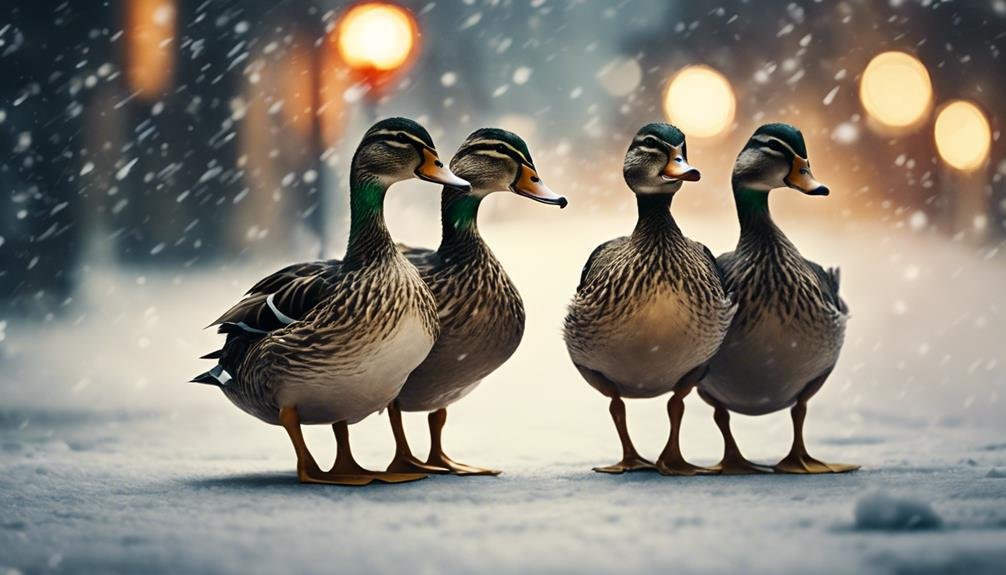Snowstorms create a unique opportunity for hunters, as ducks alter their feeding habits and fly shorter distances to their evening feeds, making them more vulnerable. Low visibility and disrupted navigation further increase their susceptibility. By positioning themselves near roosting areas and understanding duck behavior, hunters can capitalize on this advantage. Adapting strategies to the snowstorm's unpredictability and utilizing effective decoy placement can lead to success. As the snowflakes fall, hunters who master the snowstorm showdown can reap the rewards – and grasping the secrets of this unique hunting dynamic requires a deep understanding of the intricate dynamics at play.
Key Takeaways
- Snowstorms disrupt duck behavior, causing them to alter their feeding habits and fly shorter distances to their evening feeds.
- Low visibility in snowstorms makes navigation difficult for ducks, increasing their vulnerability to hunters.
- Decoy placement near the roost or along flight paths can be highly effective in snowstorm hunting, as ducks prioritize proximity to their roost.
- Hunters must adapt their strategies to capitalize on the unique opportunities presented by snowstorms, including identifying feeding areas and timing their hunt.
- Dressing in layers, choosing waterproof gear, and packing essential items like hand and toe warmers are crucial for cold safety and survival in snowy conditions.
Snowstorm Hunting Advantages
Duck hunters often prefer hunting in snowstorms due to the urgency it invokes in waterfowl, making them decoy with reckless abandon. Snowstorms disrupt duck behavior, causing them to alter their feeding habits and fly shorter distances to their evening feeds. This change in behavior makes them more accessible to hunters. Low visibility in snowstorms also makes navigation difficult for ducks, further increasing their vulnerability. Hunters can capitalize on these advantages by positioning themselves close to the roost, increasing their chances of success. Understanding duck behavior and weather patterns is essential in snowstorm hunting, allowing hunters to adapt their strategies and capitalize on the unique opportunities presented by these conditions.
Decoy Placement Strategies
Capitalizing on the heightened sense of urgency that drives waterfowl to abandon caution, hunters must strategically place their decoys to intercept these driven ducks. Fresh strategies are essential to outsmart these wary birds. To maximize success, hunters should focus on decoy placement that mimics the ducks' natural behavior.
| Decoy Placement | Effectiveness |
|---|---|
| Edge of flooded fields | High |
| Near roosting areas | Medium |
| Along flight paths | High |
Timing the Snowfall Flight
As the snowflakes begin to fall, a sense of urgency sets in, prompting waterfowl to abandon their cautious nature and fly recklessly to their feeding grounds, presenting hunters with a unique opportunity to intercept them. To capitalize on this window, hunters must employ precise timing strategies. Identifying snowfall windows, when ducks are most active, is vital. This narrow timeframe allows hunters to position themselves at the feeding grounds, increasing their chances of success. By understanding the timing of snowfall flights, hunters can adapt their strategies to intercept ducks during these critical moments, maximizing their harvest. Effective timing is key to a successful snowstorm hunt, and hunters who master this aspect will reap the rewards.
Adapting to Snowy Conditions
Snowy conditions impose a unique set of challenges on hunters, requiring them to adapt their strategies and tactics to capitalize on the opportunities presented by the unpredictable weather. To successfully navigate these conditions, hunters must be prepared with the right Winter Gear, prioritizing Cold Safety above all else. This includes dressing in layers, wearing waterproof clothing, and bringing essential items like hand and toe warmers.
- Dress in layers: This will help regulate body temperature and prevent overheating.
- Choose waterproof gear: This will protect hunters from the elements and keep them dry and comfortable throughout the hunt.
- Pack essential items: Hand and toe warmers, thermal beverages, and energy-rich snacks can be lifesavers in extreme cold.
Low-Visibility Hunting Tactics
In low-visibility conditions, hunters must rely on their auditory senses to locate and track waterfowl, making it essential to develop a keen sense of hearing and awareness of subtle sounds. In a frozen landscape, the crunch of snow underfoot or the soft quack of a duck can be the difference between a successful hunt and a fruitless endeavor. Hunters must be attuned to these subtle cues, using their ears to paint a mental picture of the surroundings. Winter camo and concealment become vital in these conditions, as the reduced visibility makes it easier for ducks to spot hunters. By mastering low-visibility hunting tactics, hunters can turn the tables and gain the upper hand in the snowy showdown.
Feeding Patterns in Snow
During intense snowfall, ducks drastically alter their feeding patterns, opting for shorter flights to nearby fields and prioritizing proximity to their roost over traditional feeding grounds. This shift in behavior is essential for hunters to understand, as it presents unique opportunities for success. In snowy landscapes, ducks adapt to the harsh conditions by:
- Prioritizing proximity: Ducks favor fields closest to their roost, reducing energy expenditure and minimizing exposure to the elements.
- Shortening flight distances: Ducks take shorter flights to conserve energy, making them more accessible to hunters.
- Altering feeding schedules: Ducks adjust their feeding times to coincide with the snowfall, providing hunters with a narrow window of opportunity.
Understanding these adaptations is vital for hunters to capitalize on the unique benefits of snowstorm hunting. By recognizing these changes in duck behavior, hunters can position themselves for success in the snowy landscape.
Snowstorm Hunting Benefits
Hunters who brave the harsh conditions of a snowstorm are often rewarded with unparalleled opportunities to bag their quarry, as the adverse weather amplifies the urgency and predictability of duck behavior. Snowstorms alter duck behavior, making them more accessible to hunters. Winter strategies, such as setting up decoys near roosting sites, become more effective as ducks fly shorter distances to their evening feeds. Low visibility in snowstorms makes navigation difficult for ducks, altering their feeding habits and making them more predictable. By understanding these changes in duck behavior, hunters can adapt their winter strategies to capitalize on the benefits of snowstorm hunting, increasing their chances of success in the field.
Hunting Near Roosting Sites
Positioning oneself near roosting sites is a crucial strategy in snowstorm hunting, as ducks tend to fly shorter distances to their evening feeds in snowy conditions, often using the first few fields closest to their roost. This proximity allows hunters to capitalize on the Flappy Friends' predictable behavior, leveraging Weather Wisdom to outsmart them. To increase success, hunters should:
- Identify the roosting site and set up decoys in the adjacent fields.
- Be prepared for ducks to arrive quickly, as they prioritize feeding in harsh weather.
- Remain patient and vigilant, as the snowstorm's reduced visibility can make ducks more cautious.
Overcoming Visibility Challenges
Snowstorms' reduced visibility can create a cat-and-mouse game between hunters and ducks, as the latter rely on their keen senses to navigate through the whiteout. In snowy landscapes, hunters must adapt to overcome the challenges of limited visibility. Ducks, accustomed to the frozen habitat, rely on their exceptional senses to detect food and predators. To succeed, hunters must blend into the snowy environment, using camouflage and concealment to get close to their quarry. By understanding the ducks' behavior in snowy conditions, hunters can set up effective ambushes, exploiting the reduced visibility to their advantage. By doing so, they can turn the tables on their feathered foes, capitalizing on the snowstorm's unique opportunities.
Snowstorm Hunting Essentials
When the snowflakes start falling, a well-planned strategy and essential gear become vital to capitalizing on the unique opportunities presented by snowy conditions. Winter strategies require adaptability and flexibility to overcome the snowy challenges that come with hunting in harsh weather. To increase success, hunters should prioritize the following essentials:
- Water-resistant gear: Protect your equipment from the elements to ensure reliability and functionality.
- Insulated clothing: Stay warm and focused on the hunt, even in freezing temperatures.
- High-visibility decoys: Attract ducks despite the low visibility, using decoys that stand out in the snowy landscape.
Mastering the Snowstorm Hunt
Capitalizing on the snowstorm's urgency, hunters must carefully orchestrate their setup and strategy to successfully intercept ducks in their feeding frenzy. Understanding winter patterns and bird behavior is vital to mastering the snowstorm hunt. As ducks alter their feeding habits due to low visibility, hunters can position themselves close to the roost, increasing their chances of success. By identifying the closest feeding area to the roost and setting up decoys accordingly, hunters can capitalize on the ducks' desperation for food. Timing is everything, as ducks will start flying to their feeds as soon as the snow starts falling. By being prepared and adaptable, hunters can turn the snowstorm's unpredictability to their advantage, increasing their chances of a successful hunt.
Frequently Asked Questions
How Do I Stay Warm and Dry During a Snowstorm Hunt?
To stay warm and dry during a snowstorm hunt, prioritize cold weather gear, incorporating insulating layers, waterproof jackets, and breathable base layers to maintain a comfortable body temperature and prevent moisture buildup.
Can I Use Different Decoy Spreads for Snowstorm Hunts?
Seventy-five percent of successful snowstorm hunts rely on adaptable decoy spreads. To increase chances of success, employ Decoy Diversity by mixing species, sizes, and postures, and adjust your Spread Strategy according to wind direction, snowfall intensity, and duck behavior.
What's the Ideal Snowfall Rate for a Successful Duck Hunt?
Ideal snowfall rates for a successful duck hunt range from 1-3 inches per hour, providing ideal snowy conditions that disrupt duck behavior, making them more accessible to hunters, while still allowing for manageable weather patterns.
How Do I Navigate My Way Back to My Truck After the Hunt?
As the snowstorm subsides, how will you avoid getting lost in the vast, featureless landscape? Rely on landmarks recognition and compass orientation to navigate your way back to your truck, ensuring a safe and successful return.
Are There Any Specific Snowstorm Hunting Gear Recommendations?
When hunting in snowstorms, prioritize gear that can withstand harsh conditions. Invest in snowproof camo to blend with the winter landscape and iceproof boots to guarantee traction and warmth, facilitating a successful and safe hunt.
Conclusion
In the tumultuous landscape of snowstorm hunting, understanding the dynamics of duck behavior and adapting to the unpredictable weather conditions are essential to success. As the veil of snow descends, ducks become more accessible, yet visibility dwindles. Can hunters truly master the snowstorm hunt, or will the fury of winter outsmart even the most seasoned waterfowl enthusiasts? By employing strategic decoy placement, timing the snowfall flight, and overcoming visibility challenges, hunters can capitalize on the unique opportunities presented by snowstorm hunting, ultimately emerging victorious in this winter showdown.









